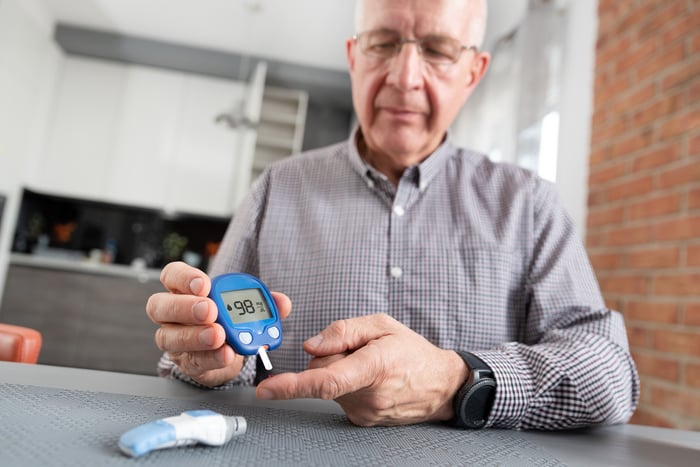The coronavirus disease 2019 (COVID-19) pandemic has made this one of the wildest year on record for the stock market. In a five-month stretch, we've witnessed the fastest bear-market descent in history, the strongest quarterly rally in 22 years, and the tech-heavy Nasdaq Composite log more than two dozen all-time highs. Suffice it to say that it's been volatile.
Generally speaking, volatility can be a great thing for investors. That's because it allows long-term-minded investors to buy into great companies at a discount.

Image source: Getty Images.
However, increased periods of volatility also have a knack for bringing short-term and novice investors out of the woodwork. Online investing platform Robinhood, which is known for attracting millennial and/or novice investors, is the current posterchild for this short-term thinking.
In recent months, we've witnessed Robinhood investors pile into Hertz following its Chapter 11 bankruptcy filing, Eastman Kodak after being awarded a $765 million government loan, and Nikola, despite the electric-truck manufacturer having not collecting a cent in revenue. Robinhood's leaderboard (i.e., a list of the platform's most-held stocks) is a minefield of generally awful companies or stocks that are hot for a very short period of time.
The thing is, Robinhood absolutely has the potential to be a platform that kick-starts young investors on their path toward financial freedom. But in order to do so, Robinhood investors will need to think for the long-term and focus on buying higher-quality businesses.
It's also important for young investors to understand that starting capital isn't a constraint. If Robinhood investors are working with $1,000 of investment capital, they have more than enough to buy game-changing stocks for the long haul. Here are three perfect examples for Robinhood's members to consider buying.

Image source: Square.
Square
First of all, forget chasing bankrupt companies and penny stocks when you have the ability to buy a financial technology powerhouse like Square (XYZ -0.02%).
Most folks probably know Square best for its seller ecosystem, which provides point-of-sale devices to small and medium-sized merchants. For years, this seller ecosystem has allowed Square to collect merchant fees.
What's really interesting, though, is that this point-of-sale platform isn't just for small businesses any longer. During the March-ended quarter, 52% of the gross payment volume (GPV) that traversed Square's network came from larger businesses, which by Square's definition entails at least $125,000 in annualized GPV. Making inroads with bigger businesses should lead to higher merchant fees and less of a payment processing drop-off when the next economic contraction strikes.
However, it's Square's Cash App that'll be its primary sales growth and profitability driver throughout the decade. Cash App is a peer-to-peer payment platform that can be used to transfer money to and from a traditional bank account, and can also be linked to Cash Card for more traditional purchasing activity. It's become especially popular during the pandemic as people shift away from using cash.
Furthermore, Robinhood's younger investors will appreciate that Cash App allows for bitcoin exchange and direct investments. Exchanging fiat currency for bitcoin is actually one of the most profitable functions for Cash App.
Wall Street is counting on Square to more than quadruple its sales between 2019 and 2023, which makes it a fintech stock Robinhood investors are going to want to own.

Image source: Getty Images.
DexCom
A second high-growth stock whose potential isn't fleeting is medical-device maker DexCom (DXCM -0.78%). And don't let its nearly $440 share price scare you off -- it has plenty of upside still to come.
DexCom is a manufacturer of continuous glucose monitoring systems (CGM) for patients with diabetes. Instead of patients pricking their fingers on a regular basis to test their blood sugar levels, a CGM provides consistent readouts that can be used two ways. Either the real-time data can be displayed on a DexCom wireless device, a smartphone, or a smartwatch for the patient to act on (if need be), or it can be sent wirelessly to an insulin pump, which will dispense doses of insulin on an as-needed basis.
Aside from the simplicity of use, DexCom's CGMs are fueling patient convenience and treatment personalization. The company's Clarity software allows diabetics to aggregate their blood glucose readings into easy-to-read digital reports that can be sent to a primary care physician or specialist. This can be especially helpful during a pandemic, with diabetics not having to leave their house to get critical data to their doctor.
Investors should also understand what a monstrous market opportunity CGMs are in the United States. According to the Centers for Disease Control and Prevention, 34.2 million people in the U.S. have diabetes (75% of which know it), with another 88 million exhibiting symptoms of prediabetes. DexCom's potential patient pool is enormous, and it continues to grow every year.
Although DexCom isn't what you'd call a fundamentally cheap stock, it is a company that's expected to deliver 20%-plus growth on an annual basis for many years to come.

Image source: Getty Images.
A third stock Robinhood investors should scoop up is social media giant Facebook (META 0.73%). It may not be the sexiest pick, considering there are other high-growth social media platforms folks could invest in, but its consistency is unmatched.
Last week, Facebook reported its second-quarter operating results, ended June 30. Even with COVID-19 as a serious headwind -- remember, most U.S. states and developed countries were on lockdown throughout much of April and some portion of May -- Facebook saw its monthly active user count grow by approximately 100 million to 2.7 billion from the sequential first quarter, with family monthly active people surpassing 3 billion to hit 3.14 billion. On a year-over-year basis, family monthly active people grew by 14%.
The point is, no social media platform offers access to more eyeballs than Facebook. Though there may be other sites with faster active user growth, it's Facebook that advertisers are going to seek out for targeted campaigns. This gives Facebook a ridiculous amount of ad-pricing power.
Another exciting aspect of Facebook is that the company is still in the relatively early innings of its growth. Though this might sound like a head-scratcher of a statement for a company that might generate $78 billion in sales in 2020, you should know that Facebook still hasn't monetized Facebook Messenger or WhatsApp. Once Facebook begins monetizing these highly popular platforms, it should see a significant surge in sales and cash flow.
As one final note, don't overlook Facebook's non-ad-based revenue potential. In the second quarter, "other" revenue spiked 40% from the previous year to $366 million. This "other" category includes the sale of Oculus virtual reality headsets and Portal, the company's smart video calling device. These innovations, along with Facebook Pay, could be sneaky growth drivers this decade.





